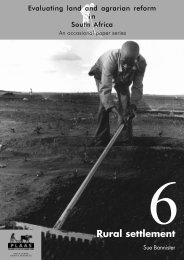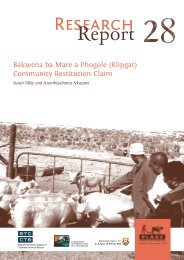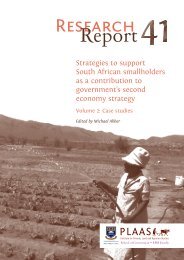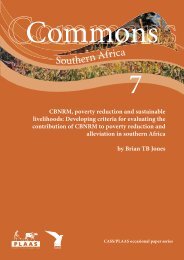A critical appraisal of South Africa's market-based land reform policy
A critical appraisal of South Africa's market-based land reform policy
A critical appraisal of South Africa's market-based land reform policy
You also want an ePaper? Increase the reach of your titles
YUMPU automatically turns print PDFs into web optimized ePapers that Google loves.
A <strong>critical</strong> <strong>appraisal</strong> <strong>of</strong> <strong>South</strong> Africa’s<br />
<strong>market</strong>-<strong>based</strong> <strong>land</strong> <strong>reform</strong> <strong>policy</strong><br />
However there is no doubt that the<br />
combination <strong>of</strong> the grant, the low (that is,<br />
production value) valuation <strong>of</strong> the <strong>land</strong>,<br />
and the DLA-organised loans from the<br />
Land Bank, has still given them a<br />
significant benefit.<br />
In all the individual projects on state<br />
<strong>land</strong>, the amount <strong>of</strong> the grant and the loan<br />
provided for the projects was calculated to<br />
just cover the <strong>land</strong> price, leaving no<br />
additional finance for any improvements in<br />
infrastructure or production. This despite<br />
many <strong>of</strong> the respondents saying that their<br />
reason for agreeing to take up the LRAD<br />
opportunity was in order to make investments<br />
in improvements such as boreholes<br />
or improving the grazing. Not surprisingly,<br />
access to finance was identified by beneficiaries<br />
as the major constraint preventing<br />
further improvements.<br />
The Manamead and Mankweng Integrated<br />
projects show through very different<br />
examples that the use <strong>of</strong> beneficiaries’<br />
‘own contribution’ is not achieving the<br />
intended outcome <strong>of</strong> ensuring commitment<br />
to the project. LRAD reduces the assessment<br />
<strong>of</strong> beneficiary commitment to purely<br />
financial terms and, in practice, this has<br />
<strong>of</strong>ten become a book entry not necessarily<br />
reflecting any actual input to the project.<br />
At Manamead the beneficiaries did not<br />
bring any assets to the projects. The assets<br />
they were already using were valued and<br />
put down as their own contribution. The<br />
relatively small place the farms have in the<br />
business operations and lives <strong>of</strong> many <strong>of</strong><br />
the Manamead beneficiaries raises questions<br />
about their level <strong>of</strong> commitment.<br />
In the Mankweng Integrated project the<br />
labour contribution has simply been<br />
calculated at the maximum amount <strong>of</strong><br />
R5 000 per person. This has done nothing<br />
to confirm or build commitment, as evidenced<br />
by members dropping out <strong>of</strong> the<br />
project before it started production despite<br />
their supposed R5 000 investment.<br />
The speed <strong>of</strong> processing <strong>of</strong> LRAD<br />
applications seems to have been improving<br />
over the years with the Manamead projects<br />
that started in 2001 taking more than a<br />
year from initiation to approval, while<br />
projects like Mankweng Integrated and<br />
Vele that were initiated in 2002 took less<br />
than six months. A year after project<br />
approval, however, <strong>land</strong> titles had still not<br />
been transferred to some beneficiaries.<br />
Communication, while very good on some<br />
projects in initial phases, has been erratic<br />
when it comes to informing beneficiaries<br />
about project approval and the dates <strong>of</strong><br />
<strong>land</strong> transfer. For example, there are gaps<br />
<strong>of</strong> months between decisions being taken<br />
by the PGC and communication <strong>of</strong> these<br />
decisions to beneficiaries.<br />
Business planning was done by the<br />
Agricultural Research Council for the<br />
projects at Manamead and Steilloop and by<br />
DoA and DLA <strong>of</strong>ficials for the others.<br />
Vaalkop was the only DLA-implemented<br />
project where the planning grant was<br />
actually spent. The business plans may<br />
have served an administrative purpose for<br />
the DLA, but there was no sign that the<br />
plans were having any effect on the nature<br />
<strong>of</strong> the production on the farms. Most <strong>of</strong> the<br />
beneficiaries who are expected to implement<br />
the plans knew nothing about them.<br />
Of the 14 beneficiaries interviewed, only<br />
three had seen the business plans for their<br />
projects, although even they did not have<br />
copies <strong>of</strong> them. These three indicated that<br />
they were quite happy with the business<br />
planning process. Seven respondents said<br />
they knew nothing about any business<br />
plans, while the remaining four had heard<br />
about business planning, but knew little<br />
about what was in the plans.<br />
None <strong>of</strong> the projects involved any deconcentration<br />
<strong>of</strong> <strong>land</strong>holding, a central<br />
factor in the success <strong>of</strong> international <strong>land</strong><br />
<strong>reform</strong>s that have brought increased productivity<br />
and contributed to economic<br />
growth and poverty reduction. All the<br />
projects acquired and continued to use<br />
<strong>land</strong> in the same ‘economic units’ as<br />
before and continued with the same <strong>land</strong><br />
use and modes <strong>of</strong> production that had<br />
existed before the <strong>land</strong> transfer.<br />
The beneficiaries<br />
The individual projects involve beneficiaries<br />
who are either business people or<br />
civil servants (current or retired). Many<br />
benefited because they had the where-<br />
36
















